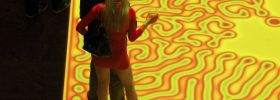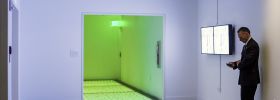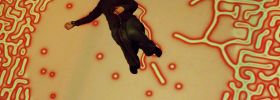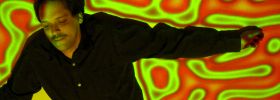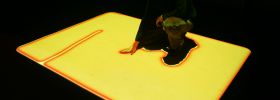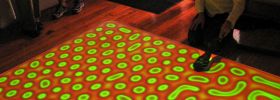Brian Knep
Healing Series
The pieces in the Healing series explore interaction and integration: the changes, both destructive and regenerative, that happen when things interface with each other. They are interactive floor projections with patterns that change in response to visitors. When visitors walk across, the patterns pull away, creating wounds. When left alone, the patterns grow to cover these wounds. In each of the pieces, however the patterns grow back in different ways.
This work is related to the research being done on artificial intelligence and artificial life, but the path and the goal are different. Most explorations in these fields attempt to create human-like intelligence and behavior, and in so doing they use more and more complex algorithms and techniques. In contrast, with these pieces I am focusing on the complexity possible with very simple rules. The patterns and their growth are completely emergent phenomena; they arise from the mathematical equations that the software simulates. The basis for these equations comes from biological and chemical models of molecular interactions, interactions that are at the core of all living things. By amplifying them and making them visible and accessible, they become metaphors for human behavior and interaction.
These pieces are not life-forms, but they exhibit life-like behaviors, behaviors that are simple in their goals—to grow—but complex and subtle in their realization—how the piece actually grows and reacts to visitors. Visitors quickly understand how the pieces react to them, but the subtlety creates many possible, often surprising, interactions. Visitors enjoy playing with the pieces and exploring new ways of interacting with them. They experiment and watch and learn from each other. The pieces encourage them to interact not only with the carpet but with each other.
